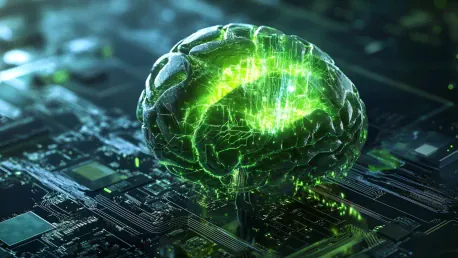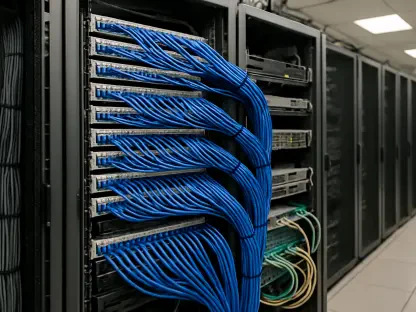Nvidia, a company once primarily known for its gaming GPUs, has made significant strides in the artificial intelligence (AI) market. This article explores Nvidia’s journey, highlighting its innovations, strategic partnerships, and the challenges it has faced.
Expanding Horizons in AI
From Gaming to AI Powerhouse
Nvidia has evolved remarkably from its origins as a gaming GPU manufacturer, adapting to the rising demand for AI technology and positioning itself as a leader in AI innovation. Initially focused on delivering high-performance graphics for gaming enthusiasts, Nvidia has successfully transitioned to providing powerful GPUs that now drive advancements in scientific simulations, data analysis, and machine learning. The company’s commitment to innovation is evident in its continuous development of cutting-edge technologies that support various AI applications and workloads. The transformation has catapulted Nvidia into many sectors that leverage AI for enhanced performance and efficiency. By expanding its GPU capabilities, Nvidia has enabled significant breakthroughs in fields such as healthcare, finance, automotive, and manufacturing. Its advanced GPUs offer unparalleled computational power, empowering researchers and developers to explore new possibilities in AI-driven solutions. This shift from gaming to AI powerhouse underscores Nvidia’s adaptability and forward-thinking approach, setting a strong foundation for its future endeavors.
Key Industry Partnerships
Over the years, Nvidia has strategically forged partnerships with giants in the tech industry, including AWS, Google Cloud, Microsoft Azure, Dell, and HPE. These collaborations have positioned Nvidia at the forefront of AI innovation, allowing the company to combine its technological expertise with the extensive resources and capabilities of its partners. Through these alliances, Nvidia has been able to provide robust AI solutions that cater to the diverse needs of various sectors, ranging from healthcare and finance to automotive and manufacturing. These partnerships have facilitated the deployment of Nvidia’s advanced GPUs and AI models across multiple platforms, enabling faster and more efficient processing of data-intensive tasks. By working with leading industry players, Nvidia has gained valuable insights and access to cutting-edge infrastructure, further enhancing its ability to deliver top-tier AI technologies. The collaborative efforts have also led to the development of innovative solutions that address specific challenges in each sector, demonstrating Nvidia’s commitment to driving progress and transformation through AI.
Innovations in Healthcare and Cybersecurity
AI in Healthcare
Nvidia’s dedication to leveraging AI in healthcare is exemplified by its February 14, 2025 initiative, which marked a significant milestone in the company’s mission to enhance AI utility in genomics and drug discovery. By partnering with leading figures in the healthcare industry, Nvidia aims to revolutionize the way medical research and patient care are conducted. The initiative focuses on harnessing the power of AI to analyze vast amounts of genomic data, identify potential drug candidates, and ultimately improve patient outcomes. The integration of Nvidia’s advanced AI technologies into healthcare applications has the potential to accelerate the discovery of new treatments and personalized medicine. By enabling researchers to process and interpret complex genomic data more efficiently, Nvidia’s AI solutions can significantly shorten the time required to develop new drugs and therapies. This commitment to innovation in healthcare demonstrates Nvidia’s broader vision of using AI to address critical global challenges and improve quality of life.
Strengthening Cybersecurity
In addition to its healthcare initiatives, Nvidia has made significant strides in enhancing cybersecurity through strategic partnerships. On February 12, 2025, the company announced collaborations with top cybersecurity firms such as Armis, Check Point Software Technologies, CrowdStrike, Deloitte, and World Wide Technology. This alliance aims to integrate Nvidia’s BlueField and Morpheus hardware with cutting-edge cyber defense software, creating robust solutions for real-time security monitoring and threat detection. By combining Nvidia’s hardware expertise with the advanced capabilities of its cybersecurity partners, the collaboration aims to provide comprehensive protection against evolving cyber threats. The integration of Nvidia’s AI-driven technologies enables faster identification and response to potential security breaches, enhancing the overall resilience of IT infrastructures. This proactive approach to cybersecurity underscores Nvidia’s commitment to safeguarding digital environments and helping organizations stay ahead of emerging threats in an increasingly connected world.
Technological Advancements and Challenges
Boosting AI Storage Speed
One of Nvidia’s notable technological advancements is the achievement of a near 50% increase in AI storage speed, announced on February 7, 2025. This significant boost was made possible by the intelligence embedded in Nvidia’s Spectrum-X Ethernet networking equipment, which combines Spectrum-4 Ethernet switches and BlueField-3 SuperNICs for superior remote direct memory access (RDMA) capabilities. The enhanced storage speed allows for more efficient data processing and transfer, critical for AI applications that require handling large volumes of data in real time. The integration of advanced networking equipment into Nvidia’s AI infrastructure exemplifies the company’s commitment to continuously pushing the boundaries of technology. By improving AI storage speed, Nvidia enables faster and more efficient execution of complex AI algorithms, facilitating the development of more sophisticated and capable AI models. This technological leap not only enhances the performance of existing AI applications but also opens up new possibilities for innovation and discovery in various fields.
Facing Market Challenges
Despite its remarkable achievements, Nvidia has faced its share of market challenges. On February 3, 2025, the unveiling of the DeepSeek-R1 LLM by Chinese AI developer DeepSeek led to an uncharacteristic 17% dip in Nvidia’s stock. This setback highlighted the competitive nature of the AI market and the constant pressure to stay ahead of emerging technologies and competitors. However, Nvidia showcased resilience by swiftly introducing the DeepSeek-R1 model as a preview Nvidia inference microservice (NIM) on build.nvidia.com. The ability to adapt and respond to market dynamics is a testament to Nvidia’s agility and strategic approach. By incorporating the DeepSeek-R1 model into its offerings, Nvidia not only addressed the immediate impact on its stock but also reinforced its commitment to providing state-of-the-art AI solutions. This incident underscores the importance of continuous innovation and vigilance in maintaining a competitive edge in the rapidly evolving AI landscape.
Strategic Developments and AI Adoption
Enhancing AI Guardrails
To address critical IT leader concerns about AI adoption, Nvidia enhanced the accuracy, security, and control of agentic AI applications by adding new NIMs to its Nvidia NeMo Guardrails software tools on January 16, 2025. These enhancements are designed to ensure that AI systems operate reliably and ethically while minimizing the risks associated with autonomous decision-making. By establishing robust AI guardrails, Nvidia aims to create a secure environment for deploying AI applications across various industries. The introduction of advanced guardrails is crucial for fostering trust and confidence in AI technologies. As AI systems become more integrated into daily operations, ensuring their reliability and security becomes paramount. Nvidia’s NeMo Guardrails provide the necessary framework for monitoring and regulating AI behavior, preventing unintended consequences, and ensuring compliance with ethical standards. This proactive approach to AI governance reflects Nvidia’s commitment to responsible AI development and deployment.
AI Factories and Project DIGITS
In its continuous effort to streamline AI development, Nvidia introduced design blueprints for AI factories on January 8, 2025. These prebuilt templates are designed to expedite the creation of AI systems, providing developers with the tools they need to build and deploy AI applications efficiently. The AI factories blueprint initiative aims to simplify the AI development process, enabling organizations to quickly scale their AI capabilities and bring innovative solutions to market. Furthermore, on January 6, 2025, Nvidia announced Project DIGITS, a groundbreaking initiative aimed at delivering desktop-scale AI supercomputing capabilities to data scientists, researchers, and students. Project DIGITS provides a shared platform for the prototyping and execution of extensive generative AI models, democratizing access to advanced AI infrastructure. By making high-performance AI computing more accessible, Nvidia empowers a broader audience to contribute to AI research and development, fostering innovation and collaboration.
Expanding AI Networking and Regulatory Scrutiny
5G Private Network Collaboration
Nvidia’s commitment to expanding AI networking capabilities is exemplified by its collaboration with Verizon on December 30, 2024. This partnership resulted in the creation of the Verizon 5G Private Network with Enterprise AI service, leveraging Nvidia’s technology to support various AI applications and workloads over low-latency 5G infrastructure. The combination of Nvidia’s advanced AI hardware and Verizon’s 5G network enables faster and more reliable data processing, crucial for real-time AI applications. The collaboration aims to provide enterprises with the necessary infrastructure to deploy AI solutions seamlessly, enhancing operational efficiency and enabling innovative applications. By harnessing the power of 5G, Nvidia and Verizon are paving the way for a new era of AI-driven services that require high-speed connectivity and low latency. This partnership underscores the importance of robust networking capabilities in realizing the full potential of AI technologies.
Regulatory Challenges
Nvidia’s acquisition strategy has not been without its regulatory challenges. On December 20, 2024, the European Commission approved Nvidia’s acquisition of Israeli AI orchestration software vendor Run:ai, marking a significant step in expanding Nvidia’s AI capabilities. However, the company still faces other regulatory examinations and geopolitical tensions that impact its operations. For instance, on December 10, 2024, China initiated an anti-monopoly investigation into Nvidia, reflecting the rising tech and trade frictions between Beijing and Washington. Navigating regulatory scrutiny and geopolitical challenges requires careful strategic planning and resilience. Nvidia’s ability to adapt and address these challenges demonstrates its commitment to maintaining its leadership position in the AI market. By proactively engaging with regulatory bodies and addressing concerns, Nvidia aims to ensure compliance while continuing to innovate and expand its technological reach.
Addressing Technical Hurdles and Global Expansion
Overcoming Overheating Issues
On November 18, 2024, Nvidia faced a significant technical hurdle when its Blackwell data center processors experienced overheating issues, causing potential delays and raising concerns among key clients such as Google, Meta, and Microsoft. The overheating problem highlighted the challenges of maintaining optimal performance and reliability in high-performance computing environments. Addressing these issues promptly and effectively was crucial to maintaining client trust and ensuring the continued success of Nvidia’s data center operations. Nvidia’s response to the overheating issues exemplified its commitment to quality and customer satisfaction. By implementing corrective measures and enhancing the cooling systems of its Blackwell processors, Nvidia aimed to prevent future occurrences and minimize disruptions. This incident underscores the importance of rigorous testing and quality assurance in the development and deployment of advanced technologies, ensuring that they meet the high standards expected by clients and stakeholders.
AI Factory Creation in India
In a strategic move to expand its global AI footprint, Nvidia announced plans on October 24, 2024, to deploy thousands of Hopper GPUs in India for the creation of AI factories. This initiative, in collaboration with Reliance Industries and other firms, aims to deliver vast computing power for AI production, supporting the development of AI-driven solutions across various sectors. The AI factory creation in India reflects Nvidia’s commitment to empowering local innovation and contributing to the global AI ecosystem. By establishing AI factories in India, Nvidia aims to tap into the country’s growing tech talent and resources, fostering collaboration and accelerating AI research and development. The initiative provides Indian startups, researchers, and enterprises with access to cutting-edge AI infrastructure, enabling them to drive innovation and create impactful solutions. This strategic expansion aligns with Nvidia’s vision of democratizing AI technology and building a global network of AI innovation hubs.
Commitment to Sustainability and AI Adoption
Energy Efficiency Advancements
Nvidia’s dedication to sustainability is evident in its continuous efforts to improve energy efficiency in AI processing. On October 8, 2024, the company outlined its advancements in reducing energy consumption, claiming significant reductions since 2014. By optimizing its AI hardware and software, Nvidia aims to minimize the environmental impact of AI technologies, addressing growing concerns over their energy demands. These energy efficiency improvements are crucial for promoting sustainable AI deployment. The company’s commitment to energy efficiency extends to its entire product portfolio, ensuring that its solutions are designed to deliver maximum performance while minimizing power consumption. By prioritizing sustainability, Nvidia not only contributes to environmental conservation but also helps organizations reduce their operational costs. This focus on energy efficiency reflects Nvidia’s broader vision of creating technology that benefits both the industry and the planet.
Expanding AI Ecosystem
Nvidia, once primarily associated with gaming GPUs, has made remarkable advancements in the artificial intelligence (AI) market. Initially gaining recognition in the gaming industry for their powerful GPU technology, Nvidia has strategically pivoted to address the burgeoning AI sector. They have developed cutting-edge hardware like the Tesla series, specifically designed for AI computations. These GPUs have fueled advancements in deep learning, a branch of AI focused on neural networks. Nvidia’s strategic collaborations with major tech companies further bolster its position in the AI market. Partnerships with companies like Google, Amazon, and Tesla have helped integrate Nvidia’s AI technology into various applications, from self-driving cars to cloud computing services. Despite the successes, Nvidia has faced considerable challenges. Competitive pressures from companies like AMD and Intel, along with the need for continuous innovation, present ongoing hurdles. Additionally, adapting their technology to rapidly evolving AI demands requires significant R&D investments. Through a blend of innovation, strategic alliances, and perseverance, Nvidia has successfully expanded beyond its gaming roots to become a pivotal player in the AI landscape. Their journey reflects a company adept at navigating a dynamic and competitive technology sector.









